Hold Curser Over Button For Contents
Note: With the latest change in the chemical makeup of lubricants, coupled with the increased thermal nature of the current internal combustion engine, the importance of oil temperature control are now even more important.
Oil Coolers
Racing cars have always required some form of oil cooler, and since World War II, most have utilized a brazed aluminum "modular" design. The basic design dates back to the early 1930's, when it was developed for use with the Rolls Royce Merlin aircraft engine.
These much copied European designed coolers, consists of a number of aluminum pressed plates, forming oil ways and end tanks. The oil ways breaks down the boundary layer effect in the flow, to obtain maximum heat dissipation, without undue pressure drop. The oil ways are interspersed with a louvered and formed aluminum strip, and brazed in a salt bath, to hold together under pressure.
The combination of heat transfer, low weight and durability in the smallest possible space, with minimal pressure drop, makes these oil coolers an international success.
Oil coolers are available in a number of heights, rows, male AN (JIC) 37 degree or BSP threaded inlets and pressure checked before leaving the factory. Two primary lengths are available (if your needs differ, inquire), all with a 2" thick, front to back measurement. The 12.1 inch mount version is the most commonly used.

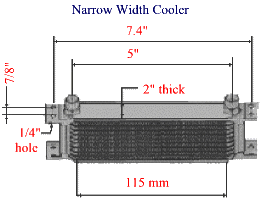
| Rows | 10 | 13 | 16 | 19 | 25 | 34 | 44 |
| Core
Height |
3.03"
77mm |
3.94"
100mm |
4.86"
124mm |
5.75"
147mm |
7.83"
194mm |
10.45"
265mm |
13.53"
344mm |
For best results, the oil cooler should be mounted
where a good volume of air is know to pass through the fins.
Mounting on the bottom brackets is sufficient in most cases,
for oil coolers up to 13 rows. In all other cases, 4 brackets should be used.
In
all cases, if the oil cooler is fitted in a situation that will subject it
to vibration or twisting, extra care must be taken in the mounting, E.g., a
system of spacers and long bolts tying all 4 brackets will spread the load or, a
mounting cradle locating with cable ties or elastic strap.
Oil Fitting Thread Sizes
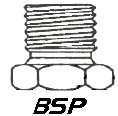
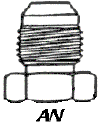
| BSP Fitting | Thread Dia. | AN (JIC) Fitting | Thread Dia. |
| 3/8 BSP | 0.56" | -6 AN | 0.66" |
| 1/2 BSP | 0.82" | -8 AN | 0.75" |
| 5/8 BSP | 0.90" | -10 AN | 0.87" |
| 3/4 BSP | 1.04" | -12 AN | 1.06" |
| -16 AN | 1.31" |
Always use a backup wrench when assembling hose ends to cooler.
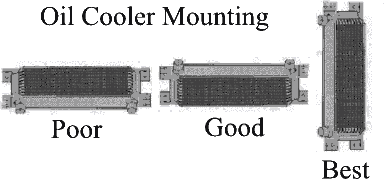
For better cooler efficiency follow these examples.
Always support the hoses attached to your oil cooler, so they do not "whip" around due to cornering forces or oil pressure spikes. Do not over-tighten hose ends to the cooler, as this will eventually distort the alloy fittings on an oil cooler. Care must be taken when connecting the oil fittings. Smear the threads and sealing faces with a thin film of oil or general purpose grease, and for final tightening of the hose ends, always use a backup wrench .
Custom Alloy Coolant Radiators
Oil Temperature Adapter
This housing has AN male fittings on both ends, and a 5/8" X18 threaded female port in the middle, to accept your capillary tube probe or temperature sending unit. Cut the hose where you want to place the adapter, fit each hose with your AN hose fitting, and you now have an access to take oil temps, without flow interruptions.
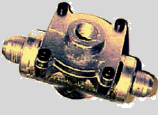
-8AN (1/2") Hose, both ends, Part #4D2706
-10AN (5/8") Hose, both ends, Part #4D1686
Oil Filter Housing
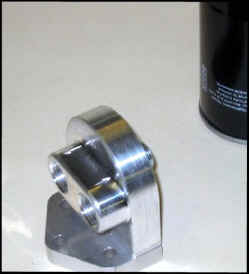
Billet aluminum remote oil filter mount from Earl's Performance Plumbing. This part has the strength to last where cheap cast versions don't. 1/2NPT port size with a 3/4"-16 thread for the filter. A commonly used filter size(PH-8, HP-1). part #9U1405
Bosch Oil Filters (not shown)
A substantial steel container withstands high pressures, excellent filter flow characteristics
(1) A versatile spin-on filter for use with the mount listed above and most
of the other common remote applications. part #5A1321
(2) Larger in diameter, but short in height spin-on filter commonly used on
Formula Ford 2000 (OHC) motors where clearance to the chassis is minimal.
part #5A1440
Overflow Catch
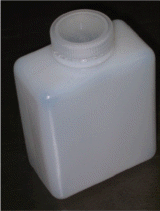
Back by popular demand, this rectangular 5" X 2.75" one (1) quart clear catch bottle is easy to attach to your vehicle. HPDE material. Measures 7" tall, including wide mouth bottle cap. Ideal for locations that round bottles just don't work. Use for oil or coolant applications. part #9U1318
Oil Pressure Switch (not shown)
This oil pressure warning switch is adjustable between 30 and 60 lbs.
1/8NPT fitting threads and a single spade connector. Set the warning pressure
high so when a problem comes about, you have more time to react. Use with one of
our 5mm or 100mm LED's (see our electrical section)
part #5D1223
Oil Thermostat (not shown)
To insure quick warm up under cold weather conditions, this unique product controls oil temperature like a thermostat controls water temperature in a radiator. The inlets are sized at -10an female, allows the oil to bypass the cooler, starts to open at 160 degrees F and is fully open at 180 degrees F. Primarily designed for passenger car and light truck usage with remote mounted oil coolers. part #5C0174

